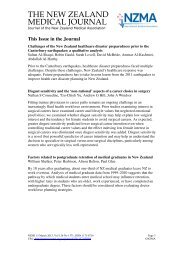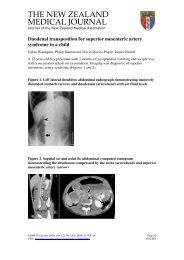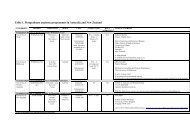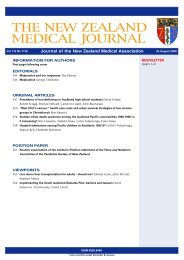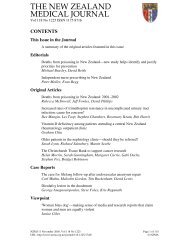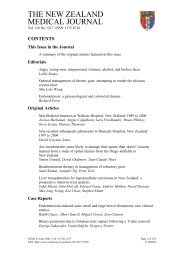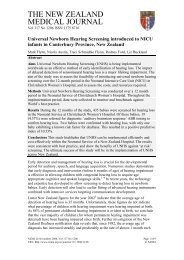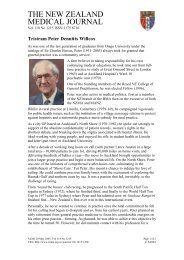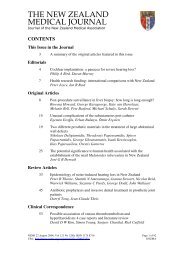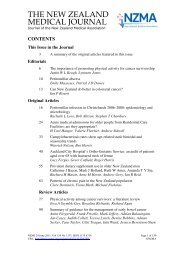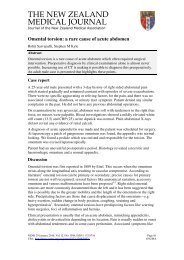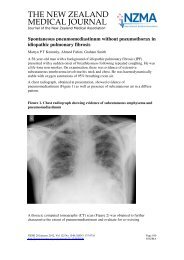Erythromycin-induced postprandial biliary colic - New Zealand ...
Erythromycin-induced postprandial biliary colic - New Zealand ...
Erythromycin-induced postprandial biliary colic - New Zealand ...
Create successful ePaper yourself
Turn your PDF publications into a flip-book with our unique Google optimized e-Paper software.
THE NEW ZEALAND<br />
MEDICAL JOURNAL<br />
Journal of the <strong>New</strong> <strong>Zealand</strong> Medical Association<br />
<strong>Erythromycin</strong>-<strong>induced</strong> <strong>postprandial</strong> <strong>biliary</strong> <strong>colic</strong><br />
Andrei M Beliaev, Peter Shapkov, Richard Ng<br />
The diagnostic workup of <strong>biliary</strong> <strong>colic</strong> includes gallbladder dyskinesia; chole-;<br />
choledocholithiasis; and benign and malignant polypoid lesions of the gallbladder;<br />
haemobilia; parasitic infestations of the liver and <strong>biliary</strong> tract such as hydatid liver<br />
disease, ascariasis, clonorchiasis, and fascioliasis; and abdominal tuberculosis.<br />
Medications such as morphine and butorphanol also can cause <strong>biliary</strong> <strong>colic</strong>. 1,2 An<br />
association of erythromycin administration and <strong>biliary</strong> <strong>colic</strong> has been reported as<br />
well. 3<br />
We report a case of erythromycin-<strong>induced</strong> <strong>postprandial</strong> <strong>biliary</strong> <strong>colic</strong>, provide liver<br />
ultrasound images of this condition, and discuss a possible mechanism of action of<br />
erythromycin on <strong>biliary</strong> tree.<br />
Case report<br />
Ms D, a 20-year-old female, presented with severe <strong>colic</strong>ky epigastric pain, which<br />
radiated to the back and was associated with nausea. Patient’s symptoms developed in<br />
3 hours after taking the first dose of 800 mg of erythromycin lactobionate for her<br />
tonsillitis.<br />
Apart from left knee meniscectomy 4 years ago Ms D had an unremarkable past<br />
medical history. She was on a long-term oral contraceptive pills and was not allergic<br />
to any medications.<br />
On examination: a slim patient, body mass index of 21.8, afebrile, haemodynamically<br />
stable with a heart rate of 92 beats per minute. Oxygen saturation was 97% on air.<br />
There was mild erythema of the paratonsillar arches without cervical or axillary<br />
lymphadenopathy. Jugular venous pressure was not raised. Heart sounds were dual.<br />
No murmurs. There were vesicular breathing sounds on auscultation of the lungs. The<br />
abdomen was guarded and tender in the epigastrium and the right upper quadrant.<br />
Bowel sounds were present.<br />
Ms D had normal findings on chest and abdominal X-ray investigations. Her blood<br />
tests results on admission demonstrated leukocytosis with white cell count (WCC) of<br />
30.6 × 10E 9 /L, normal eosinophils count, normal liver function tests (LFTs), and<br />
electrolytes.<br />
To control pain the patient required administration of 11 mg of morphine<br />
intravenously before the pain gradually settled down.<br />
Liver ultrasound investigation: the gallbladder was not identified with certainty,<br />
despite fasting for 10 hours (Figure 1). There was mild prominence of the intrahepatic<br />
bile ducts as well as the common duct (CBD=5mm). The liver appeared normal.<br />
Portal vein caliber was normal. No mass or fluid collection was identified in the<br />
epigastrium, where there was maximal focal tenderness. The pancreas, kidneys,<br />
spleen, aorta ,and para-aortic regions appeared normal.<br />
NZMJ 21 August 2009, Vol 122 No 1301; ISSN 1175 8716 Page 57<br />
URL: http://www.nzma.org.nz/journal/122-1301/3750/ ©NZMA
The next day blood tests demonstrated a rise in LFTs: gamma-glutamyl transferase<br />
225 U/L (normal range 0–50 U/L), alkaline phosphatase 76 U/L (40–100 U/L),<br />
aspartate transaminase 122 U/L (
Several studies investigated the effect of erythromycin on gallbladder emptying. 7,8<br />
Arienti et al (1994) found that a single dose of 500 mg of erythromycin stearate<br />
administered orally accelerated and increased <strong>postprandial</strong> gallbladder ejection<br />
fraction. Similar findings have been reported after intravenous administration of 500<br />
mg of erythromycin lactobionate. 8<br />
Effects of erythromycin on the hepato<strong>biliary</strong> system might depend on maturity of the<br />
gastrointestinal system. 9 Ng et al (2007) in the double-blind, randomised, placebocontrolled<br />
trial found that oral administration of 12.5 mg/kg of erythromycin every 6<br />
hours for 14 days in very-low-birth-weight infants reduced the incidence of parenteral<br />
nutrition-associated cholestasis and septicaemia. In adults, erythromycin can cause<br />
cholestatic hepatitis which usually develops in 10 to 20 days of treatment.<br />
Usually, initial symptoms of nausea, vomiting, and crampy abdominal pain are<br />
followed by jaundice and fever. Blood tests often reveal an elevation of transaminases<br />
in serum, leukocytosis, and eosinophilia. 4 A case of erythromycin-<strong>induced</strong> primary<br />
<strong>biliary</strong> cirrhosis has also been described. 10<br />
An association of treatment with erythromycin estolate and <strong>biliary</strong> <strong>colic</strong> has been<br />
reported in the literature. 3 For example, Oliver et al (1973) described five patients<br />
with <strong>biliary</strong> <strong>colic</strong> treated for a different period of time with erythromycin estolate. The<br />
authors thought that the estolate ester of erythromycin was responsible for attacks of<br />
<strong>biliary</strong> <strong>colic</strong>. There are also reports about crampy abdominal pain followed by an oral<br />
administration of erythromycin stearate and an intravenous challenge with<br />
erythromycin lactobionate. 7,8<br />
In our patient, <strong>biliary</strong> <strong>colic</strong> developed after an oral administration of a single dose of<br />
erythromycin lactobionate. These findings suggest that <strong>biliary</strong> <strong>colic</strong> might not be<br />
related to the use of a particular ester of erythromycin, but caused by the effect of<br />
erythromycin lactone ring on motilin receptors in the <strong>biliary</strong> tree.<br />
Our case report points out that a single therapeutic dose of erythromycin can cause<br />
<strong>biliary</strong> <strong>colic</strong> with transient derangement in liver function tests and leukocytosis.<br />
<strong>Erythromycin</strong>-<strong>induced</strong> <strong>biliary</strong> tree spasm must to be included in the differential<br />
diagnosis of <strong>biliary</strong> <strong>colic</strong>.<br />
Author information: Andrei M Beliaev, Surgical Registrar, Department of Surgery;<br />
Peter Shapkov, Surgical Fellow, Department of Surgery; Richard Ng, Consultant<br />
Radiologist, Radiology Department<br />
North Shore Hospital, Takapuna, Auckland<br />
Correspondence: Andrei M Beliaev, North Shore Hospital, Private Bag 93-503,<br />
Takapuna 0740, Auckland, <strong>New</strong> <strong>Zealand</strong>. Email:<br />
Andrei.Belyaev@Waitematadhb.govt.nz<br />
Reference:<br />
1. Butler KC, Selden B, Pollack CV Jr. Relief by naloxone of morphine-<strong>induced</strong> spasm of the<br />
sphincter of Oddi in a post-cholecystectomy patient.[see comment]. Journal of Emergency<br />
Medicine. 2001 Aug;21(2):129–31.<br />
2. Dolan PF. Butorphanol and <strong>biliary</strong> spasm. Anesthesiology. 1985 Sep;63(3):340.<br />
3. Oliver LE, Iser JH, Stening GF, Smallwood RA. "Biliary <strong>colic</strong>" and ilosone. Medical Journal<br />
of Australia. 1973 Jun 9;1(23):1148–50.<br />
NZMJ 21 August 2009, Vol 122 No 1301; ISSN 1175 8716 Page 59<br />
URL: http://www.nzma.org.nz/journal/122-1301/3750/ ©NZMA
.<br />
4. Chambers HF. Protein synthesis inhibitors and miscellaneous antibacterial agents. In: Brunton<br />
LL, Lazo JS, Parker KL, editors. Goodman and Gilman's the pharmacological basis of<br />
therapeutics. 11th ed. <strong>New</strong> York: McGraw-Hill; 2006. p1173–202.<br />
5. Xu L, Depoortere I, Vertongen P, et al. Motilin and erythromycin–a share a common binding<br />
site in the third transmembrane segment of the motilin receptor. Biochemical Pharmacology.<br />
2005 Sep 15;70(6):879–87.<br />
6. Farrugia G, Rich A, Rae JL, et al. Calcium currents in human and canine jejunal circular<br />
smooth muscle cells. Gastroenterology. 1995 Sep;109(3):707–17.<br />
7. Arienti V, Magri F, Boriani L, et al. Effect of single dose of oral erythromycin on gastric and<br />
gallbladder emptying. Simultaneous assessment by ultrasound. Digestive Diseases &<br />
Sciences. 1994 Jun;39(6):1309–12.<br />
8. Fiorucci S, Bosso R, Morelli A. <strong>Erythromycin</strong> stimulates gallbladder emptying and motilin<br />
release by atropine-sensitive pathways. Digestive Diseases & Sciences. 1992<br />
Nov;37(11):1678–84.<br />
9. Ng PC, Lee CH, Wong SPS, Lam HS, et al. High-dose oral erythromycin decreased the<br />
incidence of parenteral nutrition-associated cholestatis in preterm infants. Gastroenterology.<br />
2007(132):1726–39.<br />
10. Lazarczyk DA, Duffy MC. <strong>Erythromycin</strong>-<strong>induced</strong> primary <strong>biliary</strong> cirrhosis. Digestive<br />
Diseases & Sciences. 2000 Jun;45(6):1115–8.<br />
NZMJ 21 August 2009, Vol 122 No 1301; ISSN 1175 8716 Page 60<br />
URL: http://www.nzma.org.nz/journal/122-1301/3750/ ©NZMA



